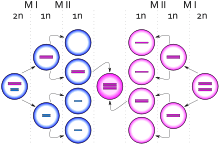48, XXXX
| XXXX syndrome | |
|---|---|
| Classification and external resources | |
| Specialty | medical genetics |
| ICD-10 | Q97.1 |
| DiseasesDB | 32550 |
XXXX syndrome (also called tetrasomy X, quadruple X, or 48, XXXX) is a rare chromosomal disorder caused by the presence of four X chromosomes instead of two X chromosomes. This condition occurs only in females, as there are no Y chromosomes present. Tetrasomy X was first described in 1961, and since then approximately 100 cases have been reported worldwide. Approximately 60 females have been described in medical literature with this condition.
Signs and symptoms
Symptoms of tetrasomy X are highly variable, ranging from relatively mild to severe. Symptoms are often similar to those of trisomy X.[1] Physically, tetrasomy X patients tend to have distinctive facial features such as epicanthal folds, flat nasal bridges, upslanting palpebral fissures, midface hypoplasia, small mouths, cleft or high arched palates, delayed or absent teeth, or enamel defects. The majority have also been reported as being longer and taller. Many also show joint and muscle tone abnormalities, including hypotonia and joint looseness in the hips. Skeletal problems may also be present, including abnormal curvatures of the spine. An informal study conducted by Tetrasomy & Pentasomy X Syndrome Information and Support found that 10% of girls had joint laxity in the hips and 20% had joint limitations in a sample size of 20 tetrasomy and pentasomy patients.
Developmentally, people with tetrasomy X frequently show mild delays in the areas of speech development and articulation, language expression and understanding, and reading skills. Delays in motor development are also present, with walking ages ranging from 16 months to 4.5 years. About 50% of patients undergo puberty normally, whereas the other 50% experiences no puberty, partial puberty without secondary sexual characteristics, or complete puberty with menstrual irregularities and/or early menopause (possibly as early as the teens). Medical literature reports four tetra-X pregnancies, two healthy, one with trisomy 21, one stillborn with omphalocele.
In terms of internal organ systems, tetrasomy X patients may have abnormal vision, hearing, circulatory systems, kidneys, or nervous systems. Disorders of the eye include myopia, nystagmus, coloboma, microphthalmus, or optic nerve hypoplasia. In terms of hearing, patients are more prone to ear infections, sound blockage, or nerve abnormalities. Several cardiac defects have also been reported, including ventricular/atrial septal defects, atresia, hypoplastic right heart syndrome, patent ductus arteriosus, and conotruncal or valvular cardiac defects. Tetrasomy X patients also appear to be more prone to seizure activity, although there is no documented abnormalities in brain function or structure when analyzed using an EEG or MRI.
Causes and diagnosis

Tetrasomy X is a chromosomal aneuploidy, meaning it arises from a defect in meiosis. This can occur when homologous X chromosomes fail to separate in the formation of the egg or sperm. Tetrasomy X is usually suspected based on symptoms present in the individual and is confirmed via karyotyping, which reveals the extra X chromosomes.
Treatment and prognosis
The general prognosis for girls with tetrasomy X is relatively good. Due to the variability of symptoms, some tetrasomy X girls are able to function normally, whereas others will need medical attention throughout their lives. Traditionally, treatment for tetrasomy X has been management of the symptoms and support for learning. Most girls are placed on estrogen treatment to induce breast development, arrest longitudinal growth, and stimulate bone formation to prevent osteoporosis. Speech, occupational, and physical therapy may also be needed depending on the severity of the symptoms.
Other species
With the Echidna, this kind of chromosomal arrangement is normal. In this species genetic sex differentiation works like this:
- 63 (X1Y1X2Y2X3Y3X4Y4X5, male) and
- 64 (X1X1X2X2X3X3X4X4X5X5, female)[2]
See also
References
- ↑ Tartaglia, Nicole R.; Howell, Susan; Sutherland, Ashley; Wilson, Rebecca; Wilson, Lennie (11 May 2010). "A review of trisomy X (47, XXX)". Orphanet Journal of Rare Diseases. 5 (8). doi:10.1186/1750-1172-5-8. PMC 2883963
 . PMID 20459843.
. PMID 20459843. - ↑ Rens, W.; et al. (2007). "The multiple sex chromosomes of platypus and echidna are not completely identical and several share homology with the avian Z". Genome Biology. 8 (11): R243. doi:10.1186/gb-2007-8-11-r243. PMC 2258203
 . PMID 18021405.
. PMID 18021405.
- Linden MG, Bender BG, Robinson A (1995). "Sex chromosome tetrasomy and pentasomy". Pediatrics. 96 (4 Pt 1): 672–82. PMID 7567329.
- Rooman RP, Van Driessche K, Du Caju MV (2002). "Growth and ovarian function in girls with 48,XXXX karyotype--patient report and review of the literature.". J Pediatr Endocrinol Metab. 15 (7): 1051–5. doi:10.1515/jpem.2002.15.7.1051. PMID 12199336.